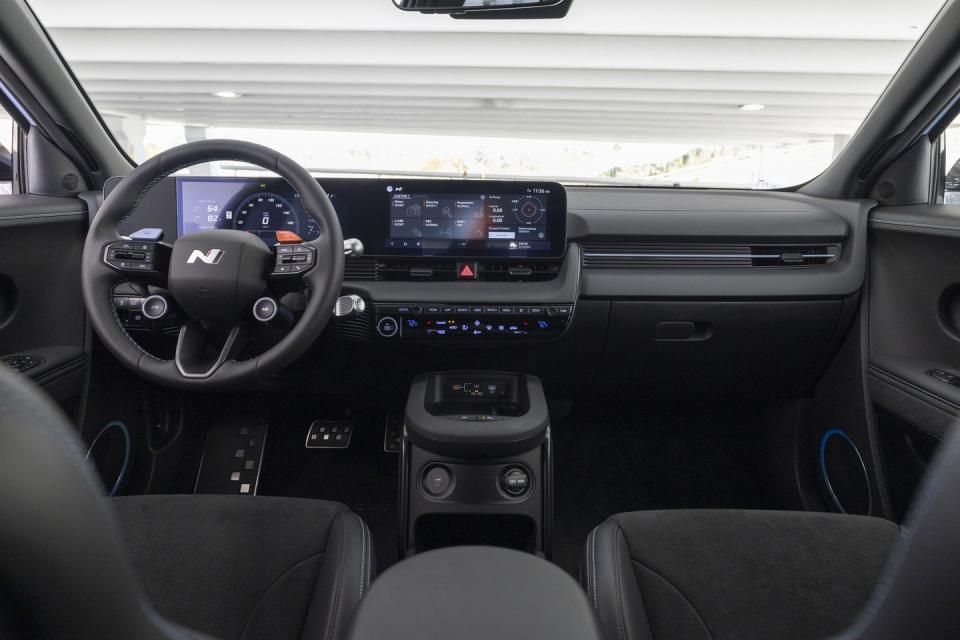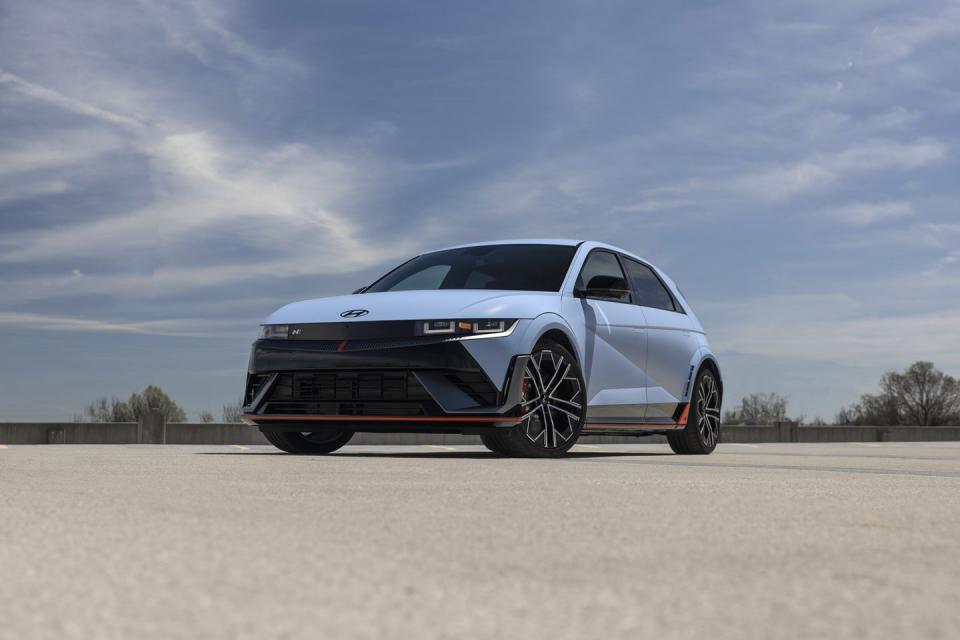We Test How the Hyundai Ioniq 5 N's Fake-Shifting Mode Makes It Slower

The electric Hyundai Ioniq 5 N has a drive mode that simulates gearchanges but reduces its acceleration times.
With N e-Shift activated, the 641-hp EV acts like it has an eight-speed dual-clutch automatic transmission, and needed 3.5 seconds to hit 60 mph.
The Ioniq 5 N's fake shifting made it four-tenths slower to 60 mph and 1.1 seconds slower to 100 mph, but the fake shifts might be more fun for some.
Welcome to Car and Driver's Testing Hub, where we zoom in on the test numbers. We've been pushing vehicles to their limits since 1956 to provide objective data to bolster our subjective impressions (you can see how we test here).
Do you remember blue ketchup? An experiment by the condiment kings at Heinz in the early 2000s turned what for nearly two centuries had been red to green, purple, orange, and, in some bottles, pink. Electric cars—not quite as old as ketchup—are having a blue-ketchup moment. Take the 641-hp Hyundai Ioniq 5 N, for example. Its ability to imitate the sounds and gearchanges of a gas-powered car make it one especially unusual tomato.
To simulate the sensations of a car with a dual-clutch automatic transmission, the all-wheel-drive Ioniq 5 N moves and makes noises, which an electric car typically wouldn't. With N e-Shift drive mode enabled, its software will drop torque between "gearshifts" and allow you to slam into a pseudo redline if you forget to upshift. It's as convincing as it is cool. Pair that with the Ignition drive sound that mimics engine noise, and you could easily fool a passenger into believing they've climbed into the seat of some custom SEMA-show Elantra N with an eight-speed dual-clutch transmission.
As senior editor Ezra Dyer said in his review, "Auditory cues are a practical advantage in a car that gathers speed like a Supermarket Sweep contestant gathers groceries." That, and the imitation pops and crackles sound far more exciting than the vacuum-cleaner-has-come-unplugged sound that EVs typically make on deceleration.
Configured for Fun
The Ioniq 5 N is the quickest Korean car we've tested, launching to 60 mph in 3.0 seconds, taking 6.9 seconds to get to 100 mph, and reaching the quarter-mile in 11.1 seconds at 123 mph. To achieve those times, we used the Ioniq 5 N's Drag mode, which needs roughly 20 minutes to pre-warm the battery. We used launch control to ensure the car was configured for maximum quickness.

This time around, we threw some of that serious business out the window as we entered the depths of Hyundai's infotainment menus to toggle on all of the fun. Due to drive-mode restrictions, we had to run our standing start twice to accurately measure the comparison with and without fake shifting.
With N e-Shift mode enabled, the Ioniq 5 N won't allow the use of N Grin Boost (good for 40 horsepower of extra oomph) or launch control. We kept the Ioniq 5 N in N mode and its softest suspension setting to allow for additional squat to help with grip, but we still used Drag mode to condition the battery. Letting the software automatically handle shifts was quicker, so we kept our greedy paws away from the paddle shifters too.
The Cost to Floss
We began this test using those settings as our baseline, instead of relying on the results when using launch control. The Ioniq 5 N was only a tenth slower to 60 mph (3.1 seconds), 0.3 second slower to 100 mph (7.2 seconds), and 0.2 second behind in the quarter-mile (11.3 seconds) than when using launch mode.

Then we enabled N e-Shift mode, making the Ioniq 5 N burble and pop, snapping through its make-believe gears like a WRC car starting a rally stage. But the simulated drama came at a cost. With N e-Shift activated, it took the Ioniq 5 N 3.5 seconds to reach 60 mph (a four-tenth penalty), 8.3 seconds to hit 100 mph (1.1 seconds slower than without fake shifting), and 11.8 seconds to clear the quarter-mile at 117 mph (five-tenths behind our baseline). There was also a big difference in passing speeds. In the fake-shifting mode, the Ioniq 5 N was two-tenths slower from 30 to 50 mph and six-tenths slower from 50 to 70 mph. At least the fake-shifting N model is still a full second quicker to 60 mph than the less intense 320-hp Ioniq 5.
Despite what our hearts tell us, test data proves over and over that in every modern application, the automatic transmission moves cars quicker to 60 mph than even the most impressive sleight of hand can manage in the dwindling number of cars sold today with a manual transmission. In the Hyundai Ioniq 5 N, it is the virtual automatic transmission that doesn't cut the mustard like the immediacy of an EV's direct-drive unit. Still, since N e-Shift mode can be turned on or off, the decision to sacrifice quickness is a choice, and while the Ioniq 5 N is slower when it's faking gearchanges, it might fool you into falling in love with an electric powertrain.
You Might Also Like

 Yahoo Autos
Yahoo Autos 